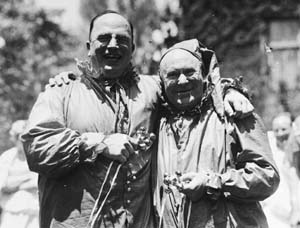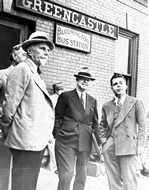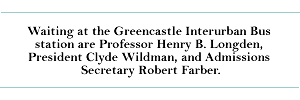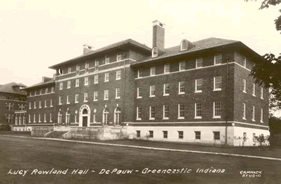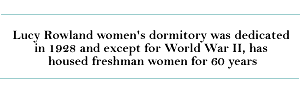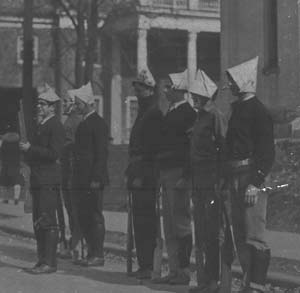
|
Chapter
3 : Pages: 1 2 3 4 5 6 7 8 9 10 Next >>
_____________________________________ The restoration of peace after the First World War ushered in a period of prosperity and growth for the university as for the nation. Not only did annual deficits become a thing of the past, but contributions from generous benefactors swelled the endowment and underwrote the construction of important new facilities. For almost a decade DePauw's student population rose steadily, passing the 1,000 mark in 1919 for the first time since the closing of the Academy and reaching 1,800 in the 1925-26 academic year.
To meet the additional teaching responsibilities, the instructional staff expanded rapidly. In the fall of 1919 the faculty gained a dozen new members, the largest number added in a single year up to that time. Most of them remained long enough-some for over 30 years-to have a major impact on the institution. The group included Walter F. Bundy in Bible; Truman G. Yuncker in botany; A. Virginia Harlow and Lester E. Mitchell in English; George B. Manhart in history; Frank T. Carlton in economics; Anna E. Olmstead (Raphael) in French and German; and Margery Simpson (Hufferd) in physics. Among those arriving in the next few years were John L. Beyl and Oscar H. Williams in education and psychology; Ralph W. Hufferd in chemistry; Catherine F. MacLaggan, Mildred Dimmick, and Percy G. Evans in Romance languages; Andrew Wallace Crandall in history; Herrick E.H. Greenleaf and William Clarke Arnold in mathematics; William R. Sherman in economics; Ernest R. Smith in geology, a new department added in 1921; Robert E. Williams in speech; Lilian B. Brownfield, Elsie D. Taylor, Lloyd B. Gale, Jerome C. Hixson, William A. Huggard, and Judith K. Sollenberger in English; George R. Gage in biology; Ruth E. Robertson in Latin; Cleveland P. Hickman in zoology; Edward R. Bartlett in religious education, a department he created in 1923; and Rheamona Green, Samuel C. Ham, Margaret Pearson (Sage), and Eugene C. Hassell in the Music School.
The administrative staff also expanded to handle the widening sphere of university operations deemed necessary in an institution of higher education in the 20th century. Harrison M. Karr served from 1920 to 1922 as an assistant to the president in carrying out the increasing tasks of that office. His successor, DePauw graduate M. Henry McLean, also undertook the duties of alumni secretary and editor of the Alumni Bulletin, in the first systematic attempt to keep in touch with former students. After 1922 the work of keeping track of student records required the efforts of a full-time registrar, Marion Bradford (Crandall), who took the place of a series of faculty members who held that post in addition to their teaching duties.
____________________________________ For lack of a faculty pension plan, many professors continued in active service well into their seventies; former President Gobin did not retire from teaching until he reached the age of 80 in 1922. In that same year, however, the trustees devised DePauw's first systematic pension program, making retirement optional at 65 but compulsory at 72-the latter provision not applying to anyone who had joined the faculty before 1885. Retirees would receive a pension amounting to one-half of their salary at the time of retirement, with widows obtaining two-thirds of that sum. Later a more elaborate system affiliated with the Carnegie Foundation-backed Teachers Insurance and Annuity Association was adopted; pensions were then based on annuities financed by contributions by both the university and individual faculty members. The
demise of the wartime military training program was followed by
the establishment in January 1918 of a unit of the Reserve Officers'
Training Corps under the command of Captain John L. Frazee, who
had directed the former S.A.T.C. on the DePauw campus. He was succeeded
within a few months by Captain-later Major-Martyn H. Shute, whose
appropriate surname inspired the nickname of "Don't Shoot."
In a close vote the trustees decreed that participation in the program
should be compulsory for all able-bodied freshman and sophomore
males, thus reverting to a practice of the last quarter of the 19th
century, when the university's cadet corps was in its heyday. Upperclassmen
who took the advanced military classes and attended a summer training
camp were eligible for commissions as second lieutenants in the
U.S. Army Reserve upon graduation. DePauw's R.O.T.C. unit frequently
won high commendations from military officials, but opposition to
its presence on campus gradually mounted in the ensuing years, especially
in Methodist and pacifist circles. It was often noted that DePauw
was apparently the only Methodist-related college or university
to maintain a compulsory military training program of that kind. |
Depauw University e-history | E-mail comments to: archives@depauw.edu
